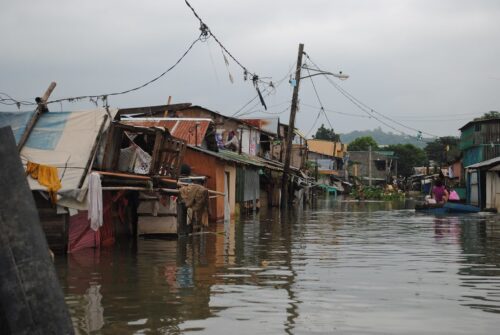Image courtesy of Arlynn Aquino.
Of the natural disasters that disrupt families and livelihoods, none makes a larger impact than the mighty flood. Globally, damages due to flooding cost 651 billion dollars from 2000 to 2019, not to mention the tens of thousands of lives lost. Vulnerability to the effects of flooding, however, also encompasses psychological trauma, disease, and forced migration. A new study suggests that while humanity is unlikely to witness a catastrophic worldwide deluge for the foreseeable future, growing numbers of people are becoming vulnerable to the effects of flooding due to climate change and rapid changes in population, infrastructure, and land use.
Researchers from the Dartmouth Flood Observatory (DFO), Google, and Cloud to Street, a firm that maps flood-exposed communities worldwide, used satellite imagery collected by the MODIS imaging sensor aboard NASA’s Terra and Aqua satellites to measure rapid changes in landscapes after floods. While these satellites can only capture images at a 250-meter resolution, they cover all of Earth’s surface daily. Using this data from 913 flood events that occurred from 2000 to 2018, the team identified coastal regions inundated by major floods. They then developed a Global Flood Database to aggregate these findings.
Researchers estimated that 2.23 million square kilometers were inundated over the past two decades, and between 255 and 290 million people were directly affected by flooding. This effect was unevenly distributed worldwide; many people exposed to flooding live in South and Southeast Asia, with ninety percent of all exposures to flooding concentrated in the two regions. Most worryingly, flood-prone areas have experienced rapid population growth in recent years, to the order of fifty-eight to eighty-six million. The proportion of people exposed to flooding worldwide increased by twenty to twenty-four percent from 2000 to 2015, compared to a previous estimate of 2.6 percent from 1970 to 2010.
The study is distinctive for its emphasis on observational data as opposed to hypothetical climate modeling. “Previous estimates [of flood exposure] have used flood models, which disagree with each other a lot, and they don’t take into account [factors like] human infrastructure,” said Colin Doyle, co-author of the study and director of technology at Cloud to Street. Flood models employ algorithms to predict the depth and extent of floods in communities during hypothetical storms.
“[Our calculations were] significantly higher than any previous estimates,” Doyle said.
There are, of course, limitations to the data. For instance, the DFO only includes floods that were well-documented in news media, meaning that floods from areas with less coverage like Africa and South America were excluded. These biases underestimate the numbers exposed. Thus, the substantially higher estimates suggested by the study remain conservative.
What does this mean for people who reside in these areas and the governments that manage them? Only about thirteen percent of disaster funds are allocated toward preparedness, mitigation, and adaptation. “Putting money in beforehand towards preparation […] is about four times more effective in terms of reducing loss versus responding afterwards,” Doyle noted. He added that investments should be made in “green infrastructure and insurance so that the most vulnerable people in low- and middle-income countries have a safety net when they need it.” With these steps, perhaps, floods will wash away fewer people’s homes and livelihoods.

